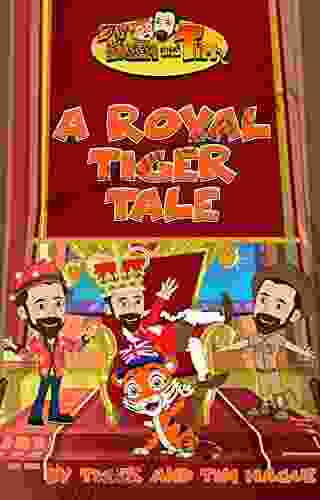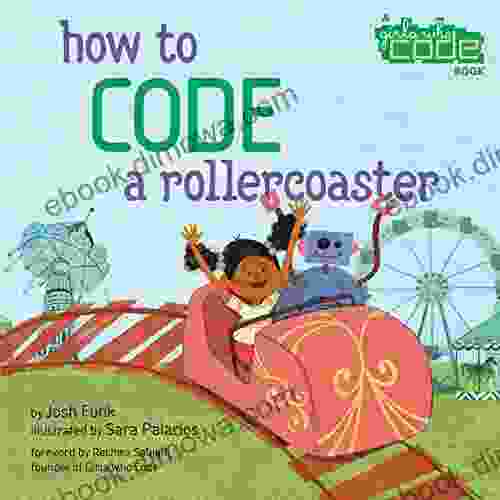How to Code a Rollercoaster in Python: A Step-by-Step Guide to Building Thrilling Virtual Rides

Rollercoasters are one of the most popular attractions at amusement parks. They're also one of the most complex, involving a combination of physics, geometry, and engineering. But what if you could create your own rollercoaster, without having to build a physical one? With Python, you can.
4.7 out of 5
| Language | : | English |
| File size | : | 16046 KB |
| Screen Reader | : | Supported |
| Print length | : | 44 pages |
| Paperback | : | 28 pages |
| Reading age | : | 7 years and up |
| Item Weight | : | 1.76 ounces |
| Dimensions | : | 6 x 0.07 x 9 inches |
In this guide, we'll show you how to code a rollercoaster in Python. We'll cover everything from the physics and geometry involved to the Python code itself. By the end, you'll be able to build your own thrilling virtual rides.
The Physics of Rollercoasters
Before we start coding, let's take a quick look at the physics of rollercoasters. Rollercoasters work by using the principles of gravity and momentum. When a rollercoaster is pulled up to the top of a hill, it gains potential energy. This energy is converted into kinetic energy as the rollercoaster rolls down the hill. The rollercoaster's speed increases as it descends, and it reaches its maximum speed at the bottom of the hill.
The shape of a rollercoaster's track is also important. The track is designed to create a variety of forces on the riders, including centrifugal force, centripetal force, and gravity. These forces keep the riders in place and give them the feeling of weightlessness.
The Geometry of Rollercoasters
The geometry of a rollercoaster's track is also important. The track is typically made up of a series of curves and straight lines. The curves are designed to create a variety of forces on the riders, while the straight lines allow the riders to rest.
The radius of a curve is the distance from the center of the curve to the track. The sharper the curve, the smaller the radius. The radius of a curve affects the amount of centrifugal force that is exerted on the riders. The smaller the radius, the greater the centrifugal force.
The Python Code
Now that we've covered the physics and geometry of rollercoasters, let's take a look at the Python code. The code for a rollercoaster is relatively simple, but it does require some knowledge of Python programming.
The first step is to create a track. A track is a list of points that define the shape of the track. The points are typically stored in a two-dimensional array, where the first column represents the x-coordinates of the points and the second column represents the y-coordinates of the points.
Once you have created a track, you can create a rollercoaster. A rollercoaster is an object that moves along a track. The rollercoaster's position is determined by its x-coordinate and y-coordinate. The rollercoaster's velocity is determined by its x-velocity and y-velocity.
To move the rollercoaster, you need to update its position and velocity at each time step. The following code shows how to do this:
python def update_position_and_velocity(rollercoaster, track): # Update the rollercoaster's position. rollercoaster.x += rollercoaster.x_velocity * dt rollercoaster.y += rollercoaster.y_velocity * dt
# Update the rollercoaster's velocity. rollercoaster.x_velocity += rollercoaster.x_acceleration * dt rollercoaster.y_velocity += rollercoaster.y_acceleration * dt
The `update_position_and_velocity()` function takes two arguments: a rollercoaster object and a track object. The function updates the rollercoaster's position and velocity by using the following equations:
x = x + x_velocity * dt y = y + y_velocity * dt x_velocity = x_velocity + x_acceleration * dt y_velocity = y_velocity + y_acceleration * dt
where:
- `x` is the rollercoaster's x-coordinate
- `y` is the rollercoaster's y-coordinate
- `x_velocity` is the rollercoaster's x-velocity
- `y_velocity` is the rollercoaster's y-velocity
- `x_acceleration` is the rollercoaster's x-acceleration
- `y_acceleration` is the rollercoaster's y-acceleration
- `dt` is the time step
The `update_position_and_velocity()` function is called at each time step to update the rollercoaster's position and velocity. This allows the rollercoaster to move along the track.
In this guide, we've shown you how to code a rollercoaster in Python. We've covered everything from the physics and geometry involved to the Python code itself. By now, you should have a good understanding of how rollercoasters work and how to create your own virtual rides.
If you're interested in learning more about Python programming, I recommend checking out the following resources:
- The Python website
- The Python documentation
- Codecademy's Python course
I hope you enjoyed this guide. Happy coding!
4.7 out of 5
| Language | : | English |
| File size | : | 16046 KB |
| Screen Reader | : | Supported |
| Print length | : | 44 pages |
| Paperback | : | 28 pages |
| Reading age | : | 7 years and up |
| Item Weight | : | 1.76 ounces |
| Dimensions | : | 6 x 0.07 x 9 inches |
Do you want to contribute by writing guest posts on this blog?
Please contact us and send us a resume of previous articles that you have written.
 Book
Book Novel
Novel Page
Page Chapter
Chapter Text
Text Story
Story Genre
Genre Reader
Reader Library
Library Paperback
Paperback E-book
E-book Magazine
Magazine Newspaper
Newspaper Paragraph
Paragraph Sentence
Sentence Bookmark
Bookmark Shelf
Shelf Glossary
Glossary Bibliography
Bibliography Foreword
Foreword Preface
Preface Synopsis
Synopsis Annotation
Annotation Footnote
Footnote Manuscript
Manuscript Scroll
Scroll Codex
Codex Tome
Tome Bestseller
Bestseller Classics
Classics Library card
Library card Narrative
Narrative Biography
Biography Autobiography
Autobiography Memoir
Memoir Reference
Reference Encyclopedia
Encyclopedia Lee Smith
Lee Smith Malcolm Oakley
Malcolm Oakley Natasha Preston
Natasha Preston Judi Curtin
Judi Curtin Roger D Taylor
Roger D Taylor Margaret James
Margaret James Ronnie Close
Ronnie Close Sheila Gates
Sheila Gates Joosr
Joosr Julia Jones
Julia Jones Themistocles M Rassias
Themistocles M Rassias Jonathan Carr
Jonathan Carr Thomas Richter
Thomas Richter M J Lighthill
M J Lighthill Paul Marlowe
Paul Marlowe John Schirle
John Schirle Julian Peters
Julian Peters Stephen P Smith
Stephen P Smith Jonny Muir
Jonny Muir John Saint Ryan
John Saint Ryan
Light bulbAdvertise smarter! Our strategic ad space ensures maximum exposure. Reserve your spot today!

 Israel BellImmerse Yourself in the Heartfelt Journey of "Mother Carey Chickens" by Stacy...
Israel BellImmerse Yourself in the Heartfelt Journey of "Mother Carey Chickens" by Stacy... Vic ParkerFollow ·8.2k
Vic ParkerFollow ·8.2k H.G. WellsFollow ·5.9k
H.G. WellsFollow ·5.9k Roberto BolañoFollow ·12.7k
Roberto BolañoFollow ·12.7k Natsume SōsekiFollow ·11.5k
Natsume SōsekiFollow ·11.5k Elliott CarterFollow ·11.4k
Elliott CarterFollow ·11.4k Stuart BlairFollow ·17.6k
Stuart BlairFollow ·17.6k Edwin BlairFollow ·5.5k
Edwin BlairFollow ·5.5k Jamal BlairFollow ·5.8k
Jamal BlairFollow ·5.8k

 José Martí
José MartíUnleash the Magic Within: "That's Not a Hippopotamus,...
Step into a Realm Where...

 Cristian Cox
Cristian CoxWhere Is Thumbkin? A Journey Through Beloved Children's...
In the realm of...

 Jason Reed
Jason ReedWitness the Unforgettable Journey of "Royal Tiger Tale":...
: Embark on an extraordinary literary...

 David Baldacci
David BaldacciRicky's Dream Trip to Ancient Greece: An Unforgettable...
Embark on an Epic Journey Get ready...

 Ira Cox
Ira CoxUnleash the Freckled Venom: Embark on an Enchanting...
Dive into the Extraordinary...
4.7 out of 5
| Language | : | English |
| File size | : | 16046 KB |
| Screen Reader | : | Supported |
| Print length | : | 44 pages |
| Paperback | : | 28 pages |
| Reading age | : | 7 years and up |
| Item Weight | : | 1.76 ounces |
| Dimensions | : | 6 x 0.07 x 9 inches |











